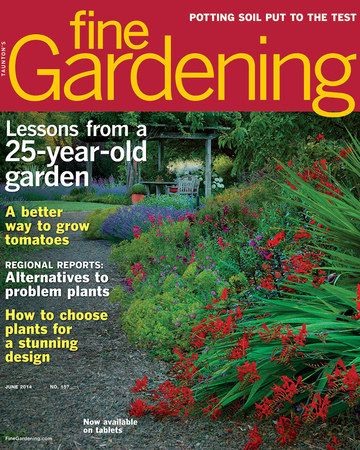Fine Gardening – Issue 157
-
Regional Picks: Alternatives to Troublesome Plants - Northeast
Troublesome Plant - Camellias (Camellia japonica cvs.) 1. Franklin Tree Name: Franklinia alatamaha USDA hardiness zones: 6 to 9 Size: 15 to 25 feet tall and 15 to 20…
-
Regional Picks: Alternatives to Troublesome Plants - Southeast
Troublesome Plant - Lupines (Lupinus spp. and cvs.) 1. Carolina Lupine Name: Thermopsis villosa USDA hardiness zones: 4 to 8 Size: 3 to 5 feet tall and 2 feet wide…
-
Regional Picks: Alternatives to Troublesome Plants - Midwest
Troublesome Plant - European privet (Ligustrum vulgare) 1. ‘Conoy’ Burkwood Viburnum Name: Viburnum × burkwoodii ‘Conoy’ USDA hardiness zones: 5 to 8 Size: 4 to 5 feet tall and 7…
-
Regional Picks: Alternatives to Troublesome Plants - Southern Plains
Troublesome Plant - Grapes (Vitis vinifera cvs.) 1. ‘Regent’ Serviceberry Name: Amelanchier alnifolia ‘Regent’ USDA hardiness zones: 4 to 9 Size: 4 to 6 feet tall and wide Conditions:…
-
Regional Picks: Alternatives to Troublesome Plants - Northern Plains
Troublesome Plant - Ornamental cherries (Prunus spp. and cvs.) 1. Coralburst® Crabapple Name: Malus ‘Coralcole’ USDA hardiness zones: 3 to 9 Size: 12 feet tall and 10 feet wide…
-
Regional Picks: Alternatives to Troublesome Plants - Central California
Troublesome Plant - Pampas grass (Cortaderia selloana and cvs.) 1. ‘Karl Foerster’ Feather Reed Grass Name: Calamagrostis × acutiflora ‘Karl Foerster’ USDA hardiness zones: 5 to 9 Size: 2 to…
-
Regional Picks: Alternatives to Troublesome Plants - Northwest
Troublesome Plant - Fall asters (Symphyotrichum novae-angliae cvs.) 1. ‘Mönch’ Frikart’s Aster Name: Aster × frikartii ‘Mönch’ USDA hardiness zones: 5 to 8 Size: 2 to 3 feet tall…
-
Grow Tomatoes Vertically to Enhance Your Harvest
Tomatoes are delicious, abundant, and easy to love, but the plants on which they grow can be a challenge. Left to their own devices, tomato plants will sprawl over the…
-
How to Grow Cucumbers
Good riddance to the cucumbers of a few decades ago—those fat, green, spiny, tough-skinned, and acid-producing fruit that were once served with iceberg lettuce and bottled dressing. Today’s cucumber is…
Featured Articles
-
Ways to Improve Pollination in the Veggie Garden
Procreation in the garden is pretty simple. The pollen from a flower’s stamen has to find the ovary (pistil) in another—or sometimes the same—flower; the plant is now pollinated, and…
-
Potting Soil Put to the Test
In their natural environment, plants get everything they need to stay healthy from the soil: water, nutrients, and air. Most well-established plants living in soil rarely need more than an…
-
Trade in Your Troublesome Plants
If you’ve ever grown plants, odds are that you’ve tried a plant that you couldn’t (or shouldn’t) grow for some reason. Did your grandma grow lilacs on her farm in…
-
Pick a Color, Any Color
Last spring, we challenged our readers to design a container that featured a single color. Whether you have a passion for purple, a yen for yellow, or an obsession for…
-
Create a Garden with Cohesiveness
Have you ever noticed that the best gardens have a seamless continuity? These spaces, which are often featured in gardening books and magazines, always seem to flow together beautifully because…
-
Lessons Learned From a 25-Year-Old Garden
Mary and Lew Reid never looked back after abandoning a beautiful established garden to start from scratch. But when you’re moving from a densely shaded garden at the foot of…
-
The Best Varieties of Campanula
Contemplating the myriad of campanulas makes me feel like a kid in a candy store. The diversity of floral shapes, blossom colors, and plant habits is both astounding and enticing.…
-
How to Control the Beetles That Damage the Garden
Proper identification is necessary before choosing a method of control
-
Our Favorite Varieties of Cucumbers
Many people wouldn’t dream of a garden without cucumbers. Fortunately for gardeners and food lovers, there are several cucumber varieties to choose from. One of the oldest agricultural crops, cucumbers…























